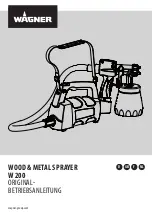
English |
21
– Pour the spray material into the container
(7)
up to no
more than the 800 mark
.
– Turn the suction tube
(13)
so that the spray material can
be sprayed with almost no residue:
For spray jobs on horizontal
surfaces/objects
Towards the
front
in the dir-
ection of the nozzle/air cap
For spray jobs overhead
Towards the
rear
in the dir-
ection of the handle
– Carry out a test-spray run on a test surface.
If the spray pattern is optimal, you can begin spraying.
or
If the spraying results are unsatisfactory or no paint is emit-
ted: (see "Troubleshooting", page 24)
Starting Operation
u
Pay attention to the mains voltage.
The voltage of the
power source must match the voltage specified on the
rating plate of the power tool.
u
Make sure that the base unit cannot draw in dust or
other contamination during operation.
u
Make sure never to spray on the base unit.
u
Stop spraying if fluid escapes from places other than
the intended nozzle during spraying, and restore the
spray gun to its proper condition.
There is a risk of elec-
tric shock.
u
Do not direct the fine-spray system against yourself,
other persons or animals.
Switching on (see figure E)
–
PFS 2000
: Check whether the correct nozzle cap is fit-
ted. (see "Changing the nozzle cap (
– Plug the mains plug into a plug socket.
– Grasp the spray gun by the handle and point it at the tar-
get area.
– Slide the on/off switch
(23)
forwards.
– Pull the trigger switch
(6)
on the spray gun.
Note:
Air always flows out at the air cap
(2)
when the base
unit is switched on.
Switching Off
– Let go of the trigger switch
(6)
and slide the on/off
switch
(23)
backwards.
– Pull the mains plug from the plug socket.
Working Advice
Spraying (see figure F)
Note:
Pay attention to the wind direction when you are using
the power tool outdoors.
– Firstly, carry out a spray test and adjust the spray pattern
and the spray material volume according to the spray ma-
terial.
For adjustments, see the following sections.
– Make sure to hold the spray gun with a uniform clearance
of 20–25 cm vertical to the object being sprayed.
– Begin the spraying procedure outside the target area.
– Move the spray gun evenly horizontally or vertically ac-
cording to the spray pattern configuration.
An even surface quality can be achieved when the spray
paths overlap by 4–5 cm.
– When spraying horizontal objects or spraying overhead,
hold the spray gun at a slight angle and move back from
the sprayed surface.
Risk of tripping! Be aware of potential obstacles.
– Avoid interruptions when spraying the target area.
Guiding the spray gun evenly will provide uniform surface
quality.
A non-uniform spraying angle and distance will lead to heavy
formation of paint mist and consequently an uneven surface.
– End the spraying procedure outside the target area.
Never completely empty the container for the spray material
by spraying. If the suction tube is no longer immersed in the
spray material, the spray jet will be interrupted and this will
result in an inconsistent surface.
– After breaks or refilling the container
(7)
, check the
nozzle cap
(10)
/
(9)
and the air cap
(2)
and clean them if
required.
– If the spray material settles on the air cap
(2)
or the
nozzle cap, clean the components with a suitable brush or
a damp cloth.
Adjusting the spray pattern
u
Never actuate the trigger switch (6) while adjusting
the air cap (2).
– Turn the air cap
(2)
to the required position.
Air cap
Spray jet pattern Application
Horizontal flat jet
for vertical working
direction
Bosch Power Tools
1 609 92A 687 | (16.09.2021)
Содержание PFS 1000
Страница 5: ... 5 E F G H I J 23 25 22 24 5 29 26 Bosch Power Tools 1 609 92A 687 16 09 2021 ...
Страница 6: ...6 K 9 19 18 7 13 17 13 3 17 12 2 11 10 9 10 16 1 609 92A 687 16 09 2021 Bosch Power Tools ...
Страница 298: ...298 عربي 1 609 92A 687 16 09 2021 Bosch Power Tools ...
Страница 302: ...IV 1 609 92A 687 16 09 2021 Bosch Power Tools ...
















































